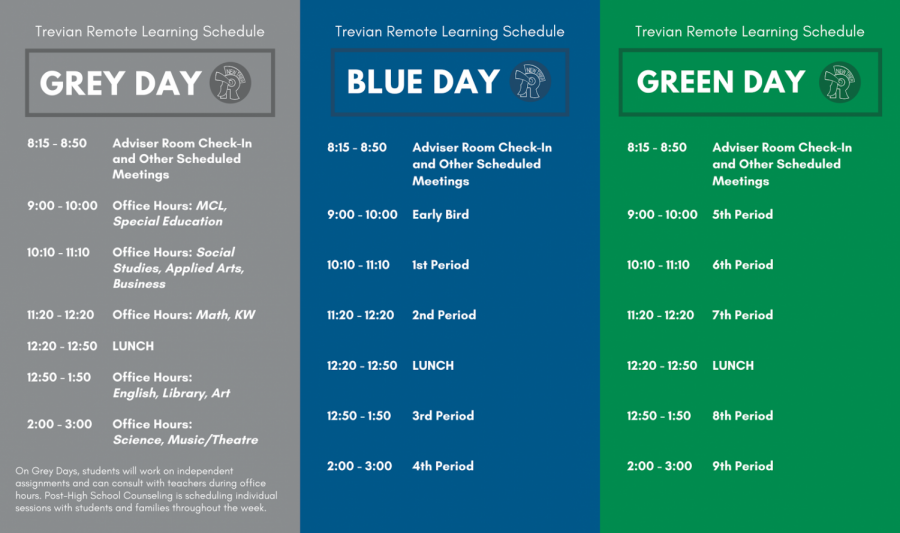The grey/blue/green schedule isn’t enough for students
The schedule for NTs remote learning week
I remember dismissing my friends’ texts when the grey/blue/green schedule was announced as nothing to worry about. They said things like “I was doing perfectly fine managing my time in the first week of remote learning,” but “This is going to cause way more stress.” Scrolling through the complaints, I reassured myself that they were wrong. Of course, they weren’t.
My friends have completely changed their minds after experiencing this block schedule, saying the day is a lot less hectic or that they are under less stress. But after the first weeks of this block schedule, I think students will never learn the minimum they need for next school year.
The nine-period system carried out during the first week of New Trier’s shutdown would have prepared students better for the obstacles they will face in the next years of high school. Why? Because the more consistently we are assigned work, the more we will have the chance to practice what we learn and be more successful academically.
Students do have responsibilities in their families, which is one of the main reasons for the schedule being established. And even though this schedule puts them at an academic disadvantage, succeeding in school is not just teachers’ responsibility. Students do have means of self-teaching they can use to counter this schedule’s flaws.
However, these flaws should be eliminated to support students as much as possible. The new grey/blue/green schedule prevents teachers from giving students a steady workload. If we see teachers every other or every three days, it will be impossible for us to receive a workload that cements in our minds the information we need to know for assignments and for next year. Simply put, many of us are going to forget the content.
If students don’t take related subjects successively, they’re less likely to retain the course content they absorbed even days before. Think about the math we forget over summer vacation. When the time comes to go back to school, it’s difficult to regain that knowledge. This block schedule may just produce a small-scale version of that effect. As repetitive as it seems, going through the academic motions every day is an essential part of information retention.
According to Queensland Brain Institute, a neuroscience research center in Australia, when the same neurological passages fire again and again, they strengthen. And when not in use, you guessed it, they weaken. It’s called synaptic plasticity. So how does this relate to our block schedule?
If we are learning similar things every day, we should be able to hammer that knowledge in so that it sticks with us forever. And that’s exactly what’s not happening with the grey/blue/green schedule. This slow repetition of content can’t sink in well enough to ensure we maintain our normal level of performance, let alone the level that will be demanded of us in the future.
In order to meet those demands, it will be necessary for us to study on our own. Online resources like Khan Academy can be used to improve in specific subjects. Reviewing old notes is also a helpful way to take advantage of synaptic plasticity.
I hope the school administration will make necessary modifications like adding more periods into the day, but, as it stands, we have reason to be doubtful of this schedule. Allowing students to work independently through all of their courses daily was challenging, but that is exactly what we need to graduate satisfied.
Like any other student, I want to have a high school experience that I can remember fondly — and one that prepares me for college. This schedule doesn’t do that. I hope the school administration will make changes quickly.








































